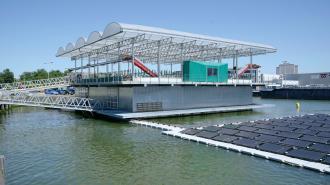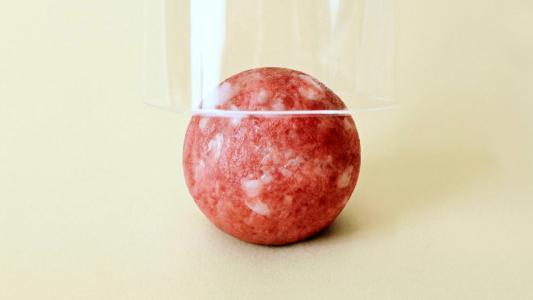Right now, half of the earth’s habitable land is used for food production — and the pressure on that finite resource is growing. To feed an additional two billion people by 2050, research indicates that global food production will have to increase by roughly 50%. Considering the inputs necessary, scaling current production methods isn’t a sustainable option.
To address the need, we’re seeing a lot of innovative solutions, from hacking the crop yield on the land we’re already using to growing food on land previously thought to be useless for agriculture.
But one couple in the Netherlands looked at the problem a little differently. While conventional wisdom would only consider habitable land for food production, Peter and Minke van Wingerden wondered why it needed to be on land at all. And that question led them to an unconventional profession: the operators of the world’s first and only floating dairy farm.
If that rings a bell, that’s because the Van Wingerden’s idea was breathlessly covered during the planning phase. But how did it all shake out? We went to Rotterdam shortly after the floating farm moved the cows in and began distributing dairy products to markets and restaurants around the city.
This interview has been edited and condensed for clarity.
Freethink: Where did the idea for a floating dairy farm come from?
Peter van Wingerden: We were looking at New York after Hurricane Sandy hit. That was really, really bad. What struck me the most was that the stores were empty. The shelves were empty of fresh food. A city only has two or three days of fresh food and that depends completely on transportation. We said, why not design a farm that can feed cities from the water? So no matter what happens, we can always produce healthy food close to the consumer. So that’s how it started, and we took it from there, and we designed a prototype over here in our port in Rotterdam.
Freethink: How does it work?
Peter: We’re designing, developing, engineering floating farms on the water. What we have is a building with production and processing. And in many farms, this is completely divided: farms are producing and industry is processing. And what we’ve done here is we combined that.
It is a three-layer building. So there’s one part below the water that is really cool in temperature, so we can use that as a cool space. Then there is a processing area in the main layer, and then we have the third layer as a stable. We collect rainwater from the roof. The rainwater is being filtered with a membrane technology and then goes back as drinking water for the cows. We have floating solar panels next door which provide us with energy.
We’re still waiting for a windmill, and we’re looking into hydrogen. We want to be completely self-sufficient over here on energy, water, and feed stock. We also process the manure to make it a fertilizer to give back to the city. So we not only provide dairy to the city, but also the manure as a fertilizer.
Freethink: Beyond just not using additional land, what are the other advantages to your farm?
Peter: We have to reinvent cities. We have to mind what kind of nutrients are in the city. What are we producing? What are we throwing away? What are we disposing, and can we reuse that? For us, it’s very important to produce healthy food close to consumers. So what we’re doing here for instance, we have shortcut nearly all transportation.
We also collect bio waste from the city. For instance, we work with a beer brewery. We get the waste from the beer brewery. We work with golf courses: we get the grass from the golf course. We work with the biggest football stadium over here: we get the grass from them too. Our animals can upscale the bio waste, and it can ultimately be consumed by human beings.
And we sell the dairy only inside our city. So we keep all nutrients inside the city without any transportation. That is essential for circular cities.
Freethink: Is this a humane place to keep cattle?
Peter: For us, animal welfare is essential. The entire world is watching. We did a lot of research on what could be the best stable for our cows. We have a very famous university on agriculture, and they said there are three elements essential for a good stable. That is space for the cow, a soft floor, and fresh food.
So what we did here is we created double the space compared to a regular stable. We have a rubber floor. We have rubber poles so the animals will not hurt themselves, and we have fresh food every day from the city. We created, in our opinion, one of the best stables in the world.
Freethink: Could this be replicated in other places in the world?
Peter: We can do this everywhere, and we have requests now from all over the world. There are countries that do not have space at all, like Singapore for instance. There are countries that are continuously flooded like Bangladesh. We have created an engine. You put the plug in, and it runs — and it can be done everywhere because the characteristics of water are almost the same everywhere. The wind can be a bit more rough or less, and the waves can be higher or lower, but it’s almost the same.
We wanted to do something to create a better world, and that’s what we’re showing over here.
Freethink: What’s been the most challenging part of this process?
Peter: The most difficult part was getting permits. Getting permits was really, really difficult because the standard reaction is, why? Why should we do it? I mean, we have (been operating dairy farms) for hundreds of years in an old-fashioned way. Why transform this? That was the most difficult part. But now, now we’ve done this, and we have visitors every day.
Freethink: What’s next for you and the farm?
Peter: We are now working on a portfolio with three products. We have dairy, and we will have eggs, and we will have vegetables. Next year, there will be seven thousand chickens on the water. So we will have dairy, eggs, and vegetables, within one and a half years, all on the water, completely floating. It will be very, very sizable because these modules, they can be wider, they can be longer. It can also be eight stories high.
Freethink: Why is this work so important to you?
Peter: For us, creating a better world is essential. It’s our key driver. It’s not only a passion, but we strongly believe that we have to change, and we have to change now. And so we hope to contribute to creating better cities, more sustainable cities. We also strongly believe in creating products with a viable business case. It’s funny to have subsidies. We didn’t get any, so it had to be a viable business case in the first place.






